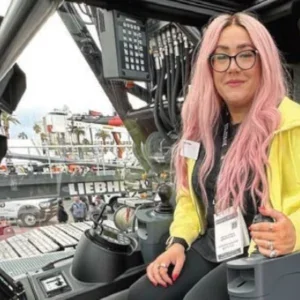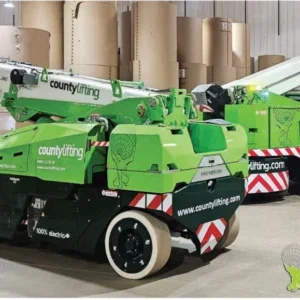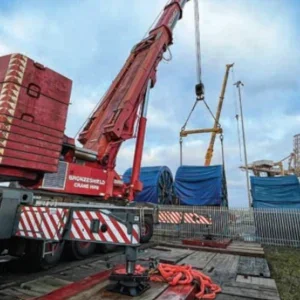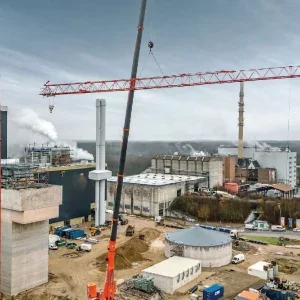Given the nature of the last decade most technological advances in almost any industry you can to name have been centred on the digital revolution. Smart tech, Industry 4.0, Big Data, and the Internet of Things have been truly transformative: we live now in a world in which even our fridges have chips in them. Small surprise then that most of the new developments in cranes and lifting technology involve one form or another of digitisation.
There are other threads though. Sustainability is one. The move to reduce or eliminate fossil fuel, diesel in particular, has led, and is leading to, electrically powered cranes – especially for city centres but by no means limited to those areas of operation.
Hydrogen is less-developed but is being spoken of as an alternative fuel, either to be burned in internal combustion engines – in which case the exhaust is water, not CO2 – or for hydrogen fuel cells. So called ‘green’ hydrogen is made by passing electricity through water, so, if the electricity source is renewable, it is genuinely carbonneutral; ‘blue’ hydrogen is sourced from cracking hydrocarbon petroleum products, so does have a carbon footprint.
Materials science is yet a third technological thread. Advances in that field have led, for example, to synthetic fibre ropes – for which see the article on page 52.
These threads are linked: there is huge overlap between materials use and recyclability, and between digital know-how and reducing carbon emissions.
Thus Italian remote control manufacturer REMdevice has, from this month (Feb 2023), digitised all its technical data and manuals and made them available on smartphone or tablet. Inside each delivered order will be a label with a QR code. Once the new owner has scanned it with their smartphone they will have direct access to the technical documentation – and have it available in more than ten languages. It is more convenient than paper and also saves trees.
Mammoet, despite specialising in the heaviest of heavy lifts, is actively on the path to carbonneutrality. Big data is key to it. Thousands of sensors, in hundreds of their vehicles and machines, are analysed by sophisticated software to show where the carbon savings can most effectively be made – see Erica Gray, Mammoet’s head of global sustainability, talking with Cranes Today about this at http://bit.ly/3IpPoa9.
But Mammoet is doing more. Paul van Gelder, CEO of Mammoet, sees the big picture. “Digitisation in the field isn’t just about keeping the business going in times of travel restrictions: it has the power to transform work for the better,” he says. “In the future customers will benefit by getting better quality data from Mammoet. For example, via the LIDAR scanning of routes or through analysis of exactly when and how cranes are used we can provide our customers with services in the most efficient and optimal ways.”
LIDAR stands for ‘Laser Imaging, Detection and Ranging’ and is, in effect, a form of aerial radar-cum-photography that ‘sees’ through tree and leaf cover to give accurate digital images of the ground beneath. It is one more technology that has moved from the science lab to everyday and affordable use.
Another such technology is the drones that can carry the surveying equipment.
Companies such as Lausanne, Switzerland based Pix4D offer such services for surveying and mapping, for example, otherwise inaccessible roof structures ahead of a planned constriction lift.
LIFT PLANNING
Mammoet’s Mammoet’s latest development in the digital field is Move 3D – software that performs virtual planning of a lift or move, ahead of time.
The move is displayed on a screen in 3D, visualised so that the move is plain to see, not only for Mammoet but for the client as well, so that any issues or conflicts in what is proposed can be discussed between them.
Lift planning is, of course, a digital application not confined to Mammoet. Among others, Florida, USA-based A1A Software has its 3D Lift Plan, which it claims is the industry’s best-known software for creating bids, critical lifts, rigging documentation and lift simulations.
The company is about to release a variety of stand-alone lift planning tools in its A1A Product Suite and will introduce a new version of its iCraneTrax. Both introductions will be during ConExpo-Con/Agg, which runs from March 14-18 this year in Las Vegas, USA.
Its Product Suite tools are j designed to help people with different roles in the crane supplier’s organisation to be functional at various levels with as little or as much complexity as the role requires. They will include ‘SketchPad’ for paperless gathering of preliminary jobsite information by drawing a sketch on a tablet. It establishes proposed crane location, travel path, and location of 3D objects, all set onto a scaled Google Map image. ‘Rigging Designer’ is a faster way to create custom rigging plans using hundreds of pre-built 3D rigging loads and objects. ‘Jobsite Designer’ allows Google 3D Buildings and Google Topography to be imported for building a more detailed job site. For operators of large crane fleets ‘Crane Search’ provides a quick search of the cranes available in the fleet to determine which ones are best suited to the project. ‘Load Chart Viewer’ provides the ability to overlay load chart data to show capacities and range diagrams, while the ‘Crane Loads Calculator’ helps determine maximum outrigger loads. There is even a ‘Mat Calculator’ to select crane pads and outrigger pads for the lift. All these apps will be available through Microsoft, Google Play, or the Apple App Store.
TECH FOR TRAINING
Training is another area where digital simulation has found a role. Montreal, Canada-based CM Labs unveiled its latest digital training tools at Bauma 2022: the immersive Vortex Advantage and the entry-level motion-enabled Vortex Edge Max.
Such simulator-training tools are becoming mainstream to the extent that they are starting to be accepted by government standards fagencies. At Bauma, for example, CM Labs showed live operator simulator training culminating with an AST (Arbeits Sicherheit &Technik) examination. The operators used CM Labs simulators to illustrate Germany’s Statutory Accident Insurance (DGUV) published guidelines approving the use of simulations for certification.
Manitowoc has gone one stage further. It is offering training on its YouTube channel, making it instantly accessible to all. Its ‘Manitowoc Garage’ YouTube channel is designed to be a go-to source of expert tutorials for a wide variety of technologies used by Manitowoc, Grove, Potain, and National Crane.
On-board electronics and graphic displays in the cab are making crane operation easier and more productive than ever before but, just as with a new smartphone, they do require operators to spend some time becoming more familiar with their proper use to deliver maximum benefits. Hence the ‘Manitowoc Garage’ YouTube channel. It is there to provide free expert instruction on that and other features of their cranes and now includes over 100 tutorial videos.
The majority of the videos focus on optimising the operation of each crane’s software, such as: reading National Crane error codes (see http://bit.ly/3Z6G6pd); calibrating the MLC650’s VPC-Max (https://bit.ly/3lvJQBY); or optimising the use of the Grove GRT9165’s suspension (http://bit.ly/40RETDH).
“The videos are short ‘howto’ customer-focussed training videos focused on the operation, service, and maintenance features of various Manitowoc models,” says John Alexander, Manitowoc’s director of technical support and service operations. “The target audience are crane operators and technicians.”
Manitowoc also offers ‘real’ instructor-led training and customer orientation and familiarisation via its dealers – which takes place during the crane delivery process. Most of the video content ties in with these but Manitowoc says it wants to provide more knowledge transfer opportunities to its enduser customer base.
“The videos are one avenue for that,” says Josh Garrington, global training manager. “Topics can come from specific sales, engineering, or product support needs as new crane features are made available. They also evolve from topics taught in our instructorled training classes that are often misunderstood and can benefit from a video reference.”
PREDICTIVE MAINTENANCE
Remote monitoring and Big Data have led to the Internet of Things whereby machine transfers data to machine, or, via the internet, to the headquarters of the machine’s manufacturer – which can be continents and time zones away. Everything can now be connected, from central heating systems to fridges to washing machines. In the lifting world, data monitoring is becoming standard: everything can be measured and recorded – from the temperature of a bearing to give advance warning that lubrication is needed, to the diameter and degree of wear on a trolley wheel.
Among the most common uses for predictive maintenance are avoidance of unplanned downtime and to give economical and fuel-saving (and carbon-footprintreducing) operating patterns – another tie-in between digitisation and eco-friendliness.
Fassi’s version of the Internet of Things (IoT) is the Internet of Cranes (or IoC) and it is applying it to its whole range of knuckle boom loader cranes – see box p46.
To go with its Internet of Cranes Fassi has another technical development that just a few years ago would have seemed pure science fiction. To service or repair a crane in the field the local technician – who does not need to be a Fassi expert – dons a pair of rather special spectacles.
They are called Next View Glasses (NVG). Video cameras in the frame transmit the view that the technician sees to a Fassi expert at Fassi headquarters. The expert works out what adjustments need to be made, or what new parts fitted; they can talk directly to the technician, advising him what to do; they can also send any documentation or service diagrams required back to the Next View Glasses, where they are projected, in colour, onto part of the lens; the technician sees both the diagram and the real-life object he is working on at the same time while he is being talked through the repair.
The expert does not need to travel so air-mile emissions are eliminated. The repair can be made on the spot and straight away so downtime is reduced. Efficiency is boosted and the process is considerably greener than before.
Technology is moving out of the laboratory into real life out on the jobsite. It's here we can see it effectively helping both the crane operator and the planet.
MAKING CONNECTIONS: FASSI'S INTERNET OF CRANES
“Fassi Gru was the fi rst company in the world to develop a remote diagnostics solution by connecting our articulated cranes to our technical assistance via the internet.” So says Roberto Signori, Fassi’s R&D manager. “With the Internet of Cranes project we wanted to propose a product innovation that actively involves crane operators during the support phase of their machines.”
Monitoring and maintenance of crane fl eets has traditionally involved the operator fi elding a team of technicians armed with tool bag and logbook who needed to travel to the site to carry out the necessary work. Fassi recognised early, as far back as 2015 (which in digital terms is another era), that remote access to vital data would enable rapid response diagnosis and assistance, from either the operator or the Fassi support team. It would also make predictive maintenance possible.
A prime requirement was constant, dependable internet connectivity. This, at that time, was a challenge, especially as Fassi has customers in all corners of the world. When the IoC project was initiated, cellular coverage was fragmented across the globe, with a mix of 2G and 3G networks and carriers using a range of communication frequencies. Fassi needed a reliable, ubiquitous connectivity solution with a single IoT data gateway and a single SIM card that would enable its cranes to communicate wherever they were deployed in the world.
Fassi worked with IoT solutions provider Micro Systems and cellular connectivity specialist Eseye for hardware and connectivity expertise. Eseye’s AnyNet SIM cards with multi-IMSI technology have the universal connectivity required to operate Fassi’s IoC system to its full potential through a single device. Eseye has access to over 700 networks and holds roaming contracts with all of the world’s major mobile phone operators covering 190 countries. This gives what is claimed as the most comprehensive localisation strategy in the IoT market today.
The bespoke electronic board designed by Micro Systems is connected to the web through the AnyNet SIM card. The board control software collects data from the crane’s control unit, then transmits it to the AWS data cloud server. The cloud server collects and securely stores data from the entire global Fassi machine fl eet around the world.
A dedicated web portal allows operators and the Fassi support centre to view and manage the data from each individual crane anywhere in the world. Benefi ts of the Internet of Cranes include improved performance and uptime. Immediate access to usage statistics brings operators a more accurate knowledge of their machines with a full understanding of their condition and how they are being used. From there, they can make adjustments and enhancements that ensure the crane is working optimally. Fassi’s own support team can monitor cranes during operation on request.
There is greater efficiency, too. Operators have been able to move from a scenario where maintenance was carried out ‘in the flesh’ by technicians to one where information is verified and managed remotely by a single operator. And there is more precise control as operators can remotely set and modify crane parameters and monitor safety. Real-time tracking of a crane’s position means they can pinpoint its location in case of theft.






